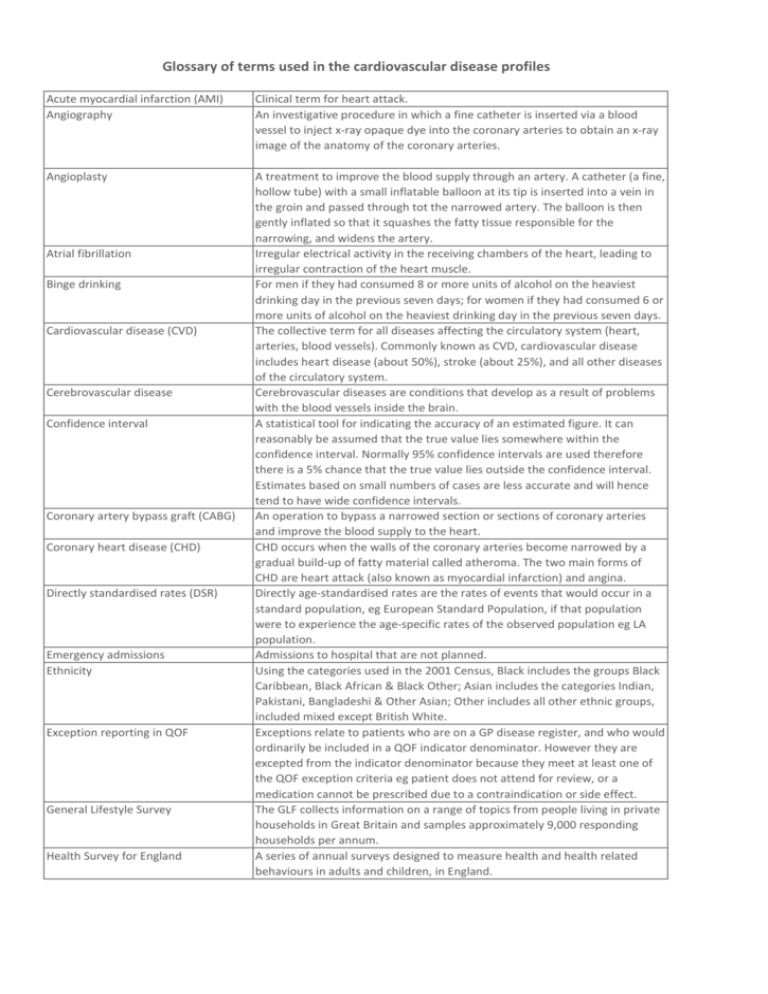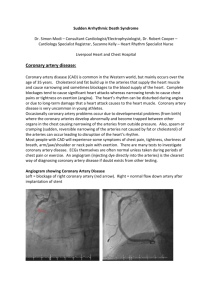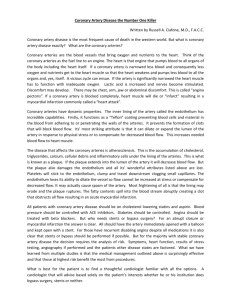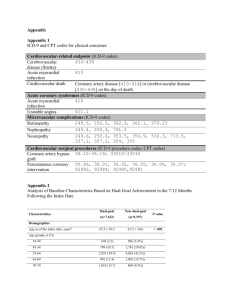Glossary of terms used in the cardiovascular disease profiles
advertisement

Glossary of terms used in the cardiovascular disease profiles Acute myocardial infarction (AMI) Angiography Clinical term for heart attack. An investigative procedure in which a fine catheter is inserted via a blood vessel to inject x-ray opaque dye into the coronary arteries to obtain an x-ray image of the anatomy of the coronary arteries. Angioplasty A treatment to improve the blood supply through an artery. A catheter (a fine, hollow tube) with a small inflatable balloon at its tip is inserted into a vein in the groin and passed through tot the narrowed artery. The balloon is then gently inflated so that it squashes the fatty tissue responsible for the narrowing, and widens the artery. Irregular electrical activity in the receiving chambers of the heart, leading to irregular contraction of the heart muscle. For men if they had consumed 8 or more units of alcohol on the heaviest drinking day in the previous seven days; for women if they had consumed 6 or more units of alcohol on the heaviest drinking day in the previous seven days. The collective term for all diseases affecting the circulatory system (heart, arteries, blood vessels). Commonly known as CVD, cardiovascular disease includes heart disease (about 50%), stroke (about 25%), and all other diseases of the circulatory system. Cerebrovascular diseases are conditions that develop as a result of problems with the blood vessels inside the brain. A statistical tool for indicating the accuracy of an estimated figure. It can reasonably be assumed that the true value lies somewhere within the confidence interval. Normally 95% confidence intervals are used therefore there is a 5% chance that the true value lies outside the confidence interval. Estimates based on small numbers of cases are less accurate and will hence tend to have wide confidence intervals. An operation to bypass a narrowed section or sections of coronary arteries and improve the blood supply to the heart. CHD occurs when the walls of the coronary arteries become narrowed by a gradual build-up of fatty material called atheroma. The two main forms of CHD are heart attack (also known as myocardial infarction) and angina. Directly age-standardised rates are the rates of events that would occur in a standard population, eg European Standard Population, if that population were to experience the age-specific rates of the observed population eg LA population. Admissions to hospital that are not planned. Using the categories used in the 2001 Census, Black includes the groups Black Caribbean, Black African & Black Other; Asian includes the categories Indian, Pakistani, Bangladeshi & Other Asian; Other includes all other ethnic groups, included mixed except British White. Exceptions relate to patients who are on a GP disease register, and who would ordinarily be included in a QOF indicator denominator. However they are excepted from the indicator denominator because they meet at least one of the QOF exception criteria eg patient does not attend for review, or a medication cannot be prescribed due to a contraindication or side effect. The GLF collects information on a range of topics from people living in private households in Great Britain and samples approximately 9,000 responding households per annum. A series of annual surveys designed to measure health and health related behaviours in adults and children, in England. Atrial fibrillation Binge drinking Cardiovascular disease (CVD) Cerebrovascular disease Confidence interval Coronary artery bypass graft (CABG) Coronary heart disease (CHD) Directly standardised rates (DSR) Emergency admissions Ethnicity Exception reporting in QOF General Lifestyle Survey Health Survey for England Heart failure Heart failure is a clinical syndrome that occurs when the heart is unable to pump enough blood to meet the demands of the body. It occurs because the heart muscle is damaged or overworked. The ‘failing heart’ keeps working but not as well as it should. Some people with mild heart failure may have very few symptoms. People with moderate or severe heart failure suffer from a number of problems, including shortness of breath, general tiredness and swelling of the feet and ankles. Hospital Episode Statistics (HES) A data warehouse that contains information on patients admitted to hospitals and outpatient attendances accross England. Hypertension High blood pressure. Hypertension happens if the walls of the larger arteries lose their natural elasticity and become rigid, and the smaller vessels constrict. Index of Multiple Deprivation (IMD This is a measure of multiple deprivation, based on the model of distinct 2010) dimensions or domains of deprivation eg employment, income, health & disability, which can be recognised and measured separately. There are 7 domains of deprivation in the IMD 2010, which can be experienced by individuals living in an area. Increasing risk and higher risk drinking (a) Increasing risk drinking is defined as usual consumption of between 22 and 50 units of alcohol per week for males, and between 15 and 35 units of alcohol per week for females. (b) Higher risk drinking is defined as usual consumption of over 50 units of alcohol per week for males, and over 35 units of alcohol per week for females. Indirectly standardised rate (ISR) Indirect standardisation is used to calculate the expected rate for the local area population, given age specific event rates from a reference population (e.g. England & Wales) The Integrated Household Survey (IHS) The Integrated Household Survey (IHS) was designed to be representative of the general, non-institutional population living in England. The sample size of the IHS for April 2010 to March 2011 on which the smoking prevalence comprises more than 250,000 adults aged 18 and over. Myocardial Ischaemia National Audit A project established in 1999 to allow hospitals to measure their performance Project (MINAP) against national standards and targets for the care of heart attack patients. National Centre for Health Outcomes Development (NCHOD) Non-elective admissions Obesity in adults Office for National Statistics (ONS) Primary angioplasty Quality and Outcomes Framework (QOF) NCHOD is a unique national resource concerned with all aspects of health outcomes assessment. One of its main activities is the production of comparative health outcome indicators using available routine data; in the form of the Compendium of Clinical and Health Indicators. Admissions to hospital that are not planned, as well as transfers from other hospitals that are not considered an emergency. Where body mass index (weight in kg divided by the square of height in metres) in adults, exceeds 30. The government department that provides statistical and registration services, and is responsible for producing a wide range of key economic and social statistics. Angioplasty is a procedure where an artery is re-opened mechanically using a balloon catheter inserted into the blocked artery. Primary angioplasty refers to using this treatment to increase blood flow to the heart in the early stages of that heart attack and is one of the recommended treatments for those diagnosed with STEMI. The effectiveness of primary angioplasty is time dependent. QOF is part of the General Medical Services contract for general practices, introduced on 1 April 2004. The QOF provides financial rewards to general practices for the provision of high quality care. It is intended to benefit both patients and the NHS. The QOF measures achievement against a scorecard of 146 indicators, pus three measures of depth of care. GP practices score points on the basis of achievement against each indicator. The QOF is made up of four domains: clinical; organisational; patient experience; and additional services. Relative gap Revascularisation Smoking Smoking quitters ST elevated Myocardial Infarction (STEMI) Stroke Modelled lifstyle estimates The relative gap is the percentage difference between the indicator value in the observed group and that in a reference group. This is a measure of differenc between the two groups. Procedures to restore blood flow through blocked coronary arteries. The two most widely used techniques are coronary artery bypass graft surgery (CABG) and percutaneous transluminal coronary angioplasty (PTCA). PTCA can also be referred to as Percutaneous coronary intervention (PCI). Those reporting they were a “current cigarette smoker” in the Integrated Household Survey for England is the general definition of 'smoker'. Number of smokers treated by a NHS Stop Smoking Service who self-report continuous abstinence from smoking from day 14 post-quit date to the fourweek follow-up point. This is a severe form of heart attack, caused by a prolonged period of blocked blood supply. It affects a large area of the heart muscle, and so causes changes on the ECG as well as in blood levels of key chemical markers. Either thrombolysis or primary angioplasty are recommended as early treatments of this condition. A stroke is the consequence of an interruption to the flow of blood to the brain. A stroke can vary in severity from a passing weakness or tingling of a limb to a profound paralysis, coma and death. Statistical modelling was used to produce estimates of lifestyle behaviours for local authorities because the annual sample size of national surveys is too small below ta certain level to provide reliable estimates. The model-based estimate for a particular LA is the expected prevalence or behaviour (high risk drinking and obesity) for that area based on its population characteristics (as measured by other data) and as such does not represent an estimate of the actual behaviour for the LA.







